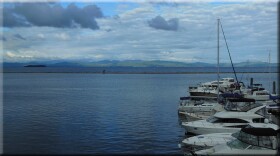Vermont Governor Peter Shumlin used two locations overlooking Lake Champlain to sign the state’s new water quality bill today.
Governor Peter Shumlin signed the legislation to clean up Lake Champlain and other Vermont waterways in both Burlington and St. Albans. Shumlin, who made the water quality bill a priority this session, said the measure not only protects waterways, but also the state’s economy and natural habitat.
The new law targets phosphorus and other pollutants coming from farms, roads, roofs and parking lots. It includes an enforcement mechanism for people who refuse to comply with the law.
Friends of Northern Lake Champlain aggressively advocated the legislature to pass the bill. Executive Director Denise Smith notes that the bill addresses a number issues including funding. “It establishes a clean water fund, something we’ve been advocating for for years. One of the things that we’re really excited about is the re-write of the accepted agricultural practices which are now going to be called the required agricultural practices. In that alone you’re establishing policy to really require producers to do the work that needs to be done. I think that what you’ll start to see is the tributaries, the rivers flowing into the lake, the change there might happen more quickly and you’ll see improved water quality there. But the first thing we have to do is reduce the nutrients that we’re sending to the lake and stop polluting.”
The Clean Water fund will provide about $10 million in state money that will allow agencies to hire more state personnel for technical assistance and regulatory enforcement.
Lake Champlain Committee Staff scientist Mike Winslow: “It’s got a lot and no one thing really rises above everything else. I think we really needed more staff in the Agency of Agriculture to do on farm inspections to insure compliance with the regulations. The bill provides that. We needed more staff within DEC make sure the regulations are being followed, to get out some education about how municipalities and permit applicants can best meet water quality goals. The bill provides those staff. So I think that’s a big piece of it. It also provides a funding mechanism for them. There’s money there to provide there to provide the staff that we need to get work done.”
Lake Champlain International Executive Director James Ehlers attended the Burlington bill signing even though he is not enthusiastic about the law. He says it’s a nice bill that meets the demands of the EPA, but has fundamental problems with the Total Maximum Daily Load allowance for phosphorus pollution. “And then there’s just cutting to the quick. The Agency of Natural Resources has looked at the problem and they’ve identified the funding requirements to solve phosphorus pollution. Mind you that doesn’t address any of the other concerns around clean water, just phosphorus. And that is a $156 million problem per year. I would like to be as gleeful as my colleagues, but I don’t see how we celebrate $7 million. It doesn’t matter what the policies are, what the regulations are, if the money isn’t there to effect them.”
The primary revenues to fund the programs will come from a property transfer tax.








